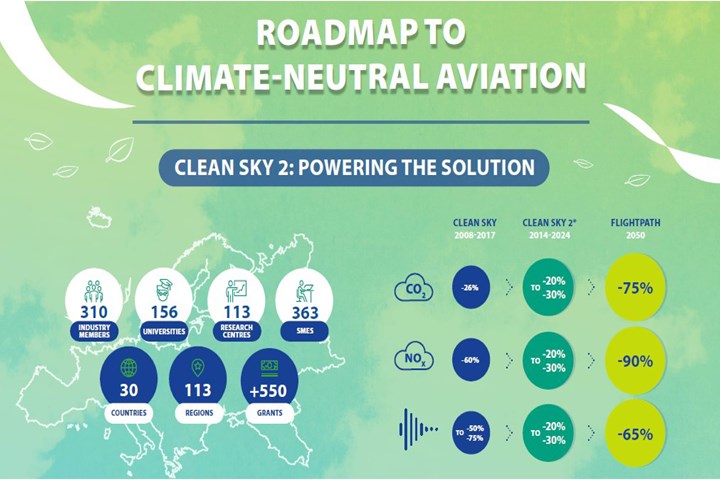Clean Sky 2 study emphasizes need for hydrogen-powered aviation development
Independent study found hydrogen as primary energy source for aircraft propulsion, outlines roadmap and required policy actions for hydrogen aviation, fuel cell technology development.

Clean Sky 2’s roadmap to hydrogen-powered aviation indicates its ambitious environmental targets, wide ecosystem of participants and key demonstrators for greener aviation. Photo Credit: Clean Sky 2
Hydrogen as an energy source will play a key role in transforming aviation into a zero-carbon/climate-neutral system over the next few decades. Novel and disruptive aircraft, aeroengine and systems innovations in combination with hydrogen technologies can help to reduce the global warming effect of flying by 50 to 90%. Moreover, these innovations can help to meet the drastic reduction targets for aviation emissions set out in the EU Green Deal.
A new independent study, commissioned by Clean Sky 2 and Fuel Cells & Hydrogen 2 Joint Undertakings on hydrogen’s potential for use in aviation, was presented at an event on June 22, 2020 which featured Adina-Ioana Vălean, the European commissioner for Transport, and Patrick Child, deputy director-general of the Directorate-General for Research and Innovation at the European Commission, as keynote speakers, in addition to leading industry representatives Stéphane Cueille (CTO, Safran, Paris France); Glen Llewellyn (vice president of Zero Emissions Technology, Airbus, Toulouse, France); David Burns (vice president of Global Business Development, Linde, Dublin, Ireland); Per Ekdunge (executive vice president of PowerCell, Sweden); and Rolf Henke (member of the Executive Board, German Aerospace Centre - DLR).
The study found that hydrogen — as a primary energy source for propulsion, either for fuel cells, direct burn in thermal (gas turbine) engines or as a building block for synthetic liquid fuels — could feasibly power aircraft with entry into service by 2035 for short-range aircraft. Indicating that it would cost less than €18 ($20) extra per person on a short-range flight, and reduce climate impact by 50-90%, the study concluded that hydrogen could play a central role in the future mix of aircraft and propulsion technologies.
According to Clean Sky 2 and Fuel Cells & Hydrogen 2 Joint Undertakings, such disruptive innovation will require significant aircraft research and development, further development of fuel cell technology and liquid hydrogen tanks, as well as investment into fleet and hydrogen infrastructure and accompanying regulations and certification standards to ensure safe, reliable and economic hydrogen-powered aircraft can take to the skies. Industry experts anticipate that it will take 10 to 15 years to make these important advancements, and that as consequence, the research needs to start now. The study estimated that the first short-range hydrogen-powered demonstrator could be developed by 2028 if sufficient investments into research and innovation (R&I) are made.
“Hydrogen in aviation offers many opportunities for the transformation of our aviation sector. From production, to distribution, to new aircraft designs and large-scale use, it provides numerous opportunities for European companies to be at the forefront of our industrial revolution in the years to come,” says Commissioner Adina-Ioana Vălean.
The technical challenges and unique characteristics of hydrogen as an on-board energy source make it best suited to commuter, regional, short-range and medium-range aircraft. For the next decades, long-haul air travel is likely to be based on liquid hydrocarbon fuels; but increasingly these too will need to be sustainable and these ‘drop-in’ fuels will also rely on hydrogen for their production.
According to the report, the following policy actions are needed:
- An aviation roadmap to guide the transition. This needs to set clear ambitions, align standards, coordinate infrastructure build-up, overcome market failures and encourage first movers.
- A strong increase in long-term R&I activities and funding. This would lead to legal and financial certainty for technology development.
- A long-term policy framework should lay out the rail guards for the sector, including how climate impact will be measured and how the roadmap will be implemented.
“Our ultimate goal is to achieve climate-neutral aviation by 2050. Turning this ambition into reality requires the seamless integration of a range of important new technological advancements, one of which is hydrogen-powered aircraft,” says Axel Krein, executive director of Clean Sky 2 Joint Undertaking. “This comes hand in hand with priorities such as hybrid engines, more electric aircraft, ultra-efficient short- and medium-range aircraft and lighter airframes. The mix of these various game-changing technologies will help us to reach our final destination.”
Emphasizing the need to turn these innovations into reality, Clean Sky 2 has outlined its roadmap to climate-neutral aviation as part of the EU’s Horizon 2020 research and innovation program in the infograph below, which indicates its ambitious environmental targets, wide ecosystem of participants and key demonstrators for greener aviation.
“The cost of producing clean hydrogen came down in recent years thanks to cheaper renewable electricity and bigger and cheaper production technology,” says Bart Biebuyck, executive director of Fuel Cells & Hydrogen 2 Joint Undertaking. “At the same time, fuel cell performance in terms of durability, capacity and cost has made big steps forward. This combination has now made it possible to look to such solutions for decarbonization of the aviation industry and the results of the study are clear on the huge potential of hydrogen in aviation. The hydrogen and fuel cell sector is ready to work hand in hand with the aviation industry to design, test and produce the required components and make zero-emission aviation an everyday reality.”
Related Content
Braided thermoplastic composite H2 tanks with co-consolidated molded boss areas to fit EV battery space
BRYSON project demonstrates possible designs, automated manufacturing and low permeability concepts, including EVOH liner and novel PPA matrix.
Read MoreComposites end markets: New space (2025)
Composite materials — with their unmatched strength-to-weight ratio, durability in extreme environments and design versatility — are at the heart of innovations in satellites, propulsion systems and lunar exploration vehicles, propelling the space economy toward a $1.8 trillion future.
Read MoreAirbus outlines next-gen single-aisle aircraft technology focuses, revised ZEROe project roadmap
Outlined technology bricks — including foldable wings, more efficient engines and propulsion and composite materials — could support a planned single-aisle next decade, plus Airbus’s renewed commitment of a commercially viable H2 aircraft.
Read MoreComposite bipolar plates provide 81% improvement to hydrogen fuel cell power density
Ultra-thin CFRTP plates developed by Hycco achieve a 7.5 kilowatt/kilogram power density, high durability for fuel cells in long-flight drone and heavy-mobility applications.
Read MoreRead Next
ZeroAvia secures additional funding to accelerate hydrogen-powered aviation
Amazon, Shell add to $21.4 million in venture funding plus U.K. government $16.3 million grant for HyFlyer II project to deliver 19-seat H2 aircraft by 2023.
Read MoreEuropean Commission issues call for clean aviation partnerships
Accepting proposals targeting hybrid electric and hydrogen-powered aircraft in 2 demonstration programs to deliver impact by 2030.
Read MoreNext-gen fan blades: Hybrid twin RTM, printed sensors, laser shock disassembly
MORPHO project demonstrates blade with 20% faster RTM cure cycle, uses AI-based monitoring for improved maintenance/life cycle management and proves laser shock disassembly for recycling.
Read More


























